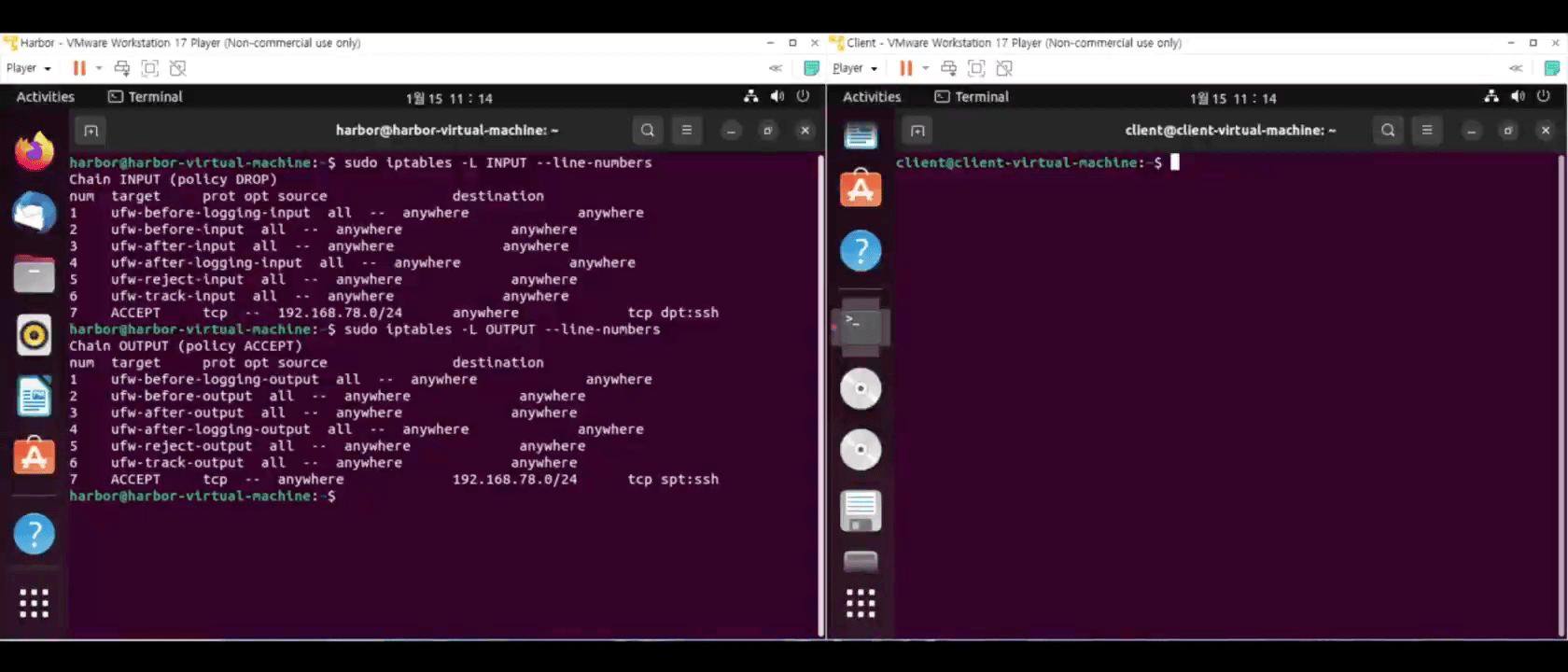Open Firewall of Linux
RECOMMEND POSTS BEFORE THIS
0. 들어가면서
Firewall에서 방화벽에 대한 기본적인 개념을 다뤘습니다. 이번 포스트에선 방화벽과 관련된 몇 가지 실습을 진행합니다.
- 방화벽 OPEN/CLOSE 확인
- 방화벽 열기
1. Context of Practice
다음과 같은 실습 환경을 구축하였습니다.
- Windows 운영체제를 사용하는 호스트(host) PC 위에 가상 머신(virtual machine) 두 대를 실행시킵니다.
- 운영체제 - Ubuntu 22.04.1
VM1IP - 192.168.78.130VM2IP - 192.168.78.132
VM1에서VM2로 SSH 접근을 수행합니다.VM1에서VM2의 “22” 포트가 열렸는지 확인합니다.VM2에서 “22” 포트에 대한 방화벽을 열어줍니다.VM1에서 SSH 접근을 수행합니다.

2. Practice
가상 머신이 2개이므로 각 명령어를 어느 머신에서 실행했는지 확인하면서 진행합니다.
2.1. Check Open/Close Firewall on VM1
VM2에 방화벽이 열려있는지 먼저 확인합니다.
방화벽이 열렸는지 확인하는 명령어는 VM1에서 실행합니다.
2.1.1. Using telnet
telnet이 설치되어 있는 경우 다음 명령어를 통해 확인이 가능힙니다.
연결 성공
$ telnet 192.168.78.132 22
Trying 192.168.78.132...
Connected to 192.168.78.132.
Escape character is '^]'.
SSH-2.0-OpenSSH_8.9p1 Ubuntu-3ubuntu0.1
Invalid SSH identification string.
Connection closed by foreign host.
연결 실패
$ telnet 192.168.78.132 22
Trying 192.168.78.132...
telnet: Unable to connect to remote host: Connection refused
2.1.2. Using built-in function of bash
telnet이 없는 경우 bash에서 제공하는 기능을 사용합니다.
폐쇄망의 경우 telnet 설치가 자유롭지 못하기 때문에 이 방법을 사용할 수 있습니다.
연결 성공
- 연결이 성공하는 경우 아무 반응이 없습니다.
$ echo > /dev/tcp/192.168.78.132/22
연결 실패
$ echo > /dev/tcp/192.168.78.132/22
bash: connect: Connection refused
bash: /dev/tcp/192.168.78.132/22: Connection refused
2.1.3. Using cURL
보통 cURL 명령어는 간단한 HTTP 요청을 수행할 때 사용하지만, telent 스키마도 지원하므로 이를 사용할 수 있다.
연결 성공
$ curl telnet://192.168.78.132:22
SSH-2.0-OpenSSH_8.9p1 Ubuntu-3ubuntu0.1
연결 실패
$ curl telnet://192.168.78.132:22
curl: (7) Failed to connect to 192.168.78.132 port 22 after 1 ms: Connection refused
2.2. Open Firewall on VM2
VM2에서 VM1이 22번 포트로 접근할 수 있도록 방화벽을 열어주는 작업을 수행합니다.
2.2.1. Install SSH Server
SSH 접근이 가능하도록 VM2에 SSH 서버를 설치합니다.
$ sudo apt-get update
Hit:1 http://kr.archive.ubuntu.com/ubuntu jammy InRelease
Hit:2 http://kr.archive.ubuntu.com/ubuntu jammy-updates InRelease
Hit:3 http://kr.archive.ubuntu.com/ubuntu jammy-backports InRelease
Hit:4 http://security.ubuntu.com/ubuntu jammy-security InRelease
Reading package lists... Done
$ sudo apt install openssh-server
Reading package lists... Done
Building dependency tree... Done
Reading state information... Done
The following packages were automatically installed and are no longer required:
libflashrom1 libftdi1-2
Use 'sudo apt autoremove' to remove them.
The following additional packages will be installed:
ncurses-term openssh-sftp-server ssh-import-id
Suggested packages:
molly-guard monkeysphere ssh-askpass
The following NEW packages will be installed:
ncurses-term openssh-server openssh-sftp-server ssh-import-id
0 upgraded, 4 newly installed, 0 to remove and 4 not upgraded.
Need to get 750 kB of archives.
After this operation, 6,046 kB of additional disk space will be used.
Do you want to continue? [Y/n] y
...
2.2.2. Running Firewall
우분투 최신 버전에서는 UFW(Uncomplicated Firewall) 명령어를 통해 방화벽을 실행합니다.
- 처음엔 방화벽이 비활성화되어 있습니다.
sudo ufw enable명령어를 통해 방화벽을 활성화시킵니다.iptables명령어를 통해 등록된 INPUT, OUTPUT 정책을 확인합니다.
$ sudo ufw status
Status: inactive
$ sudo ufw enable
Firewall is active and enabled on system startup
$ sudo ufw status
Status: active
$ sudo iptables -L INPUT --line-numbers
Chain INPUT (policy DROP)
num target prot opt source destination
1 ufw-before-logging-input all -- anywhere anywhere
2 ufw-before-input all -- anywhere anywhere
3 ufw-after-input all -- anywhere anywhere
4 ufw-after-logging-input all -- anywhere anywhere
5 ufw-reject-input all -- anywhere anywhere
6 ufw-track-input all -- anywhere anywhere
$ sudo iptables -L OUTPUT --line-numbers
Chain OUTPUT (policy ACCEPT)
num target prot opt source destination
1 ufw-before-logging-output all -- anywhere anywhere
2 ufw-before-output all -- anywhere anywhere
3 ufw-after-output all -- anywhere anywhere
4 ufw-after-logging-output all -- anywhere anywhere
5 ufw-reject-output all -- anywhere anywhere
6 ufw-track-output all -- anywhere anywhere
2.2.3. Using iptables
리눅스에서 기본으로 제공하는 iptables 명령어를 사용하였습니다.
iptables를 사용하는 경우 송신, 수신에 따라 체인(chain)을 지정해줘야 합니다.
- INPUT - 외부에서 서버로 들어오는 연결에 대한 필터
- OUTPUT - 서버에서 외부로 나가는 연결에 대한 필터
- FORWARD - 외부에서 들어온 연결이 다시 외부로 향하는 필터
다음과 같은 옵션을 사용하여 방화벽을 열었습니다.
-A [CHAIN]- 새로운 체인을 등록합니다.-p [PROTOCOL]- 어떤 프로토콜(protocol)을 사용하는지 지정합니다.-s [IP/SUBNET MASK]- 출발지의 IP 대역을 지정합니다.-d [IP/SUBNET MASK]- 도착지의 IP 대역을 지정합니다.--sport [PORT NUMBER]- 출발지의 포트 번호를 지정합니다.--dport [PORT NUMBER]- 도착지의 포트 번호를 지정합니다.-j ACCEPT- 허용-j DROP- 차단
Add INPUT Policy
외부에서 내부로 접근하는 방화벽을 열어줍니다.
VM2입장에서 INPUT 입니다.- 프로토콜은 TCP를 사용합니다.
- 출발지가 192.168.78.X 대역의 IP를 사용하는 호스트(host)만 허용합니다.
- 도착지 포트 번호는 SSH(22) 입니다.
- 해당 정책을 만족하는 트래픽(traffic)은 허용합니다.
$ sudo iptables -A INPUT -p tcp -s 192.168.78.0/24 --dport 22 -j ACCEPT
$ sudo iptables -L INPUT --line-numbers
Chain INPUT (policy DROP)
num target prot opt source destination
1 ufw-before-logging-input all -- anywhere anywhere
2 ufw-before-input all -- anywhere anywhere
3 ufw-after-input all -- anywhere anywhere
4 ufw-after-logging-input all -- anywhere anywhere
5 ufw-reject-input all -- anywhere anywhere
6 ufw-track-input all -- anywhere anywhere
7 ACCEPT tcp -- 192.168.78.0/24 anywhere tcp dpt:ssh
Add OUTPUT Policy
사실 내부에서 외부로 나가는 방화벽 정책이 없더라도 SSH 연결은 가능합니다. 그렇더라도 연습 삼아 내부에서 외부로 나가는 방화벽을 열어줬습니다.
VM2입장에서 OUTPUT 입니다.- 프로토콜은 TCP를 사용합니다.
- 도착지가 192.168.78.X 대역의 IP를 사용하는 호스트(host)만 허용합니다.
- 출발지 포트 번호는 SSH(22) 입니다.
- 해당 정책을 만족하는 트래픽(traffic)은 허용합니다.
$ sudo iptables -A OUTPUT -p tcp -d 192.168.78.0/24 --sport 22 -j ACCEPT
$ sudo iptables -L OUTPUT --line-numbers
Chain OUTPUT (policy ACCEPT)
num target prot opt source destination
1 ufw-before-logging-output all -- anywhere anywhere
2 ufw-before-output all -- anywhere anywhere
3 ufw-after-output all -- anywhere anywhere
4 ufw-after-logging-output all -- anywhere anywhere
5 ufw-reject-output all -- anywhere anywhere
6 ufw-track-output all -- anywhere anywhere
7 ACCEPT tcp -- anywhere 192.168.78.0/24 tcp spt:ssh
Reload UFW
다음 명령어를 통해 설정한 정책을 적용합니다.
$ sudo ufw reload
Firewall reloaded
Firewall Open Test

CLOSING
우분투에서 작업할 때 iptables를 서비스로 재실행하는 경우 에러가 발생합니다.
$ sudo service iptables restart
Failed to restart iptables.service: Unit iptables.service not found.
ufw enable 명령어를 통해 쉽게 방화벽을 실행할 수 있기 때문에 별도 서비스로 제공하지 않는 것 같습니다.
추가적으로 ufw 명령어를 사용하면 직관적이고 단순한 방식으로 방화벽 규칙을 설정할 수 있습니다.
다만 세밀하게 방화벽 정책을 세우기에는 iptables 명령어가 더 적절한 것 같은 느낌을 받습니다.
$ sudo ufw allow ssh
Rule added
Rule added (v6)
$ sudo ufw status
Status: active
To Action From
-- ------ ----
22/tcp ALLOW Anywhere
22/tcp (v6) ALLOW Anywhere (v6)

댓글남기기